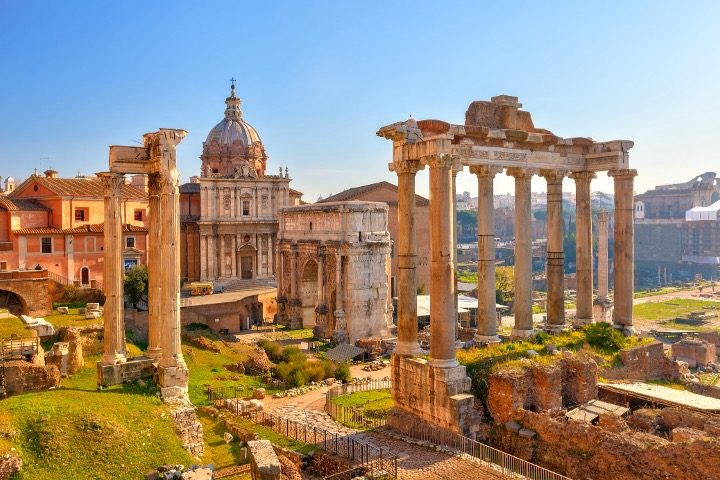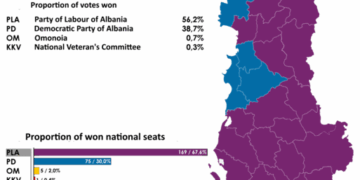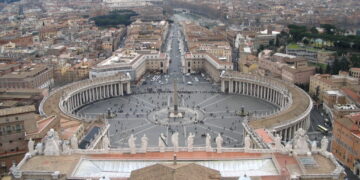
China is one of the world’s oldest civilizations. Interestingly, too, China’s Han Empire and the Roman Empire were contemporaneous and peaked at about the same time close to 2,000 years ago. But China is still around.
The Roman Empire is all gone.
The difference? “China is often considered one of the most politically, culturally, and linguistically monolithic countries in the world,” writes LitCharts.com. In other words, through famines, pestilence, bad governments, and other disasters, the Chinese people, language, and culture always remained.
In contrast, it wasn’t just that Rome comprised disparate peoples conquered in relatively short order. It’s also that it did not stress, nearly enough, the principle e pluribus unum. In fact, writes Matt O’Brien, director of investigations at the Immigration Reform Law Institute:
It is a common historical myth that Rome fell in 476 A.D. after Odoacer, King of the Goths, sacked the capital city and forced Romulus Augustus to abdicate his throne.
The historical reality is rather different. Over the course of nearly a century, Germanic tribes — fleeing everything from war, famine and tribal politics — moved, unimpeded, into Roman territory. And the Empire died not by traditional invasion but by unchecked mass migration.
Now, question: Is today’s United States more like China?
Or is it more like mid-5th-century Rome?
The Ghosts of Empires Past
Anyone unsure of the answer should consider the following, courtesy of website History’s Histories. Explaining that the “peace of Pax Romana” was followed by a long period of “confusion and violence” and political infighting, the site writes:
Food shortages led to higher prices, and because citizens were spending more of their money on basic necessities they often failed to pay taxes. The government tried to fix the economy by simply making more new coins. Flooding the marketplace with new coins, however, meant that the money had less value. As a result, prices continued to rise and it cost ever more money to buy goods. This is called inflation.
Sound familiar? Note that our legalized counterfeiting operation — aka the federal government — has increased the money supply 40 percent just since 2020. The consequent inflation has, of course, become a big election issue.
Yet economic problems alone weren’t enough to finish the great Roman Empire. As History’s Histories also informs:
As Rome struggled, Germanic tribes began to attack the empire. Since the days of Julius Caesar, Germanic peoples had gathered on the northern borders of the Empire. Some groups settled into a peaceful farming life and adopted Roman ways, such as speaking Latin and becoming Christians. Other groups remained nomads. From 376 to 476 [A.D.], huge numbers of Germans poured into Roman territory. As a result, Germanic tribes that included Ostrogoths, Visigoths, Franks, Angles, Saxons, Burgundians, Alemanni, and Vandals all competed for land, recognition, and Roman favor. Gradually, they overwhelmed the structures of Roman society. Finally, they drove the last Roman emperor from the throne.
Note, the main reason these Germanic tribes entered Rome was that they were fleeing the fierce Mongol invader the Huns. They were refugees — real ones, that is (unlike, let’s say, people seeking nanny-state handouts).
Demography Is Destiny
One chapter of this saga is especially apropos. According to Greek historian Procopius, a political power struggle caused Bonifacius, a 5th-century governor of Roman North Africa, to seek allies in the Vandals — and he invited them into North Africa. The result?
Not long after, the Vandals conquered North Africa.
Is this at all reminiscent of how a major American party floods our country with foreigners to win political power? (These aliens help this party get more congressional seats at redistricting time. This party also believes the migrants will be future supporters.)
Note that a Yale/MIT study found that there were 22 million illegal aliens in the U.S. as of 2018. The number could be considerably higher today, too.
Speaking of demographics, early A.D. Rome also wasn’t creating enough Romans. The low fertility rate was so troubling, in fact, that Emperor Augustus embraced a “family values” agenda, fined childless bachelors, and lectured the nobility on their lack of fecundity. It was to no avail.
Again, sound familiar? Note that the U.S.’s current fertility rate, 1.786 births per woman, is well below replacement level (2.1). European-descent Americans’ fertility rate is just 1.6.
Then There’s the Migration Rate
The aforementioned Matt O’Brien relates some more similarities between Rome and a land we (some of us) know and love:
During this [late empire] period, Rome was ruled by a disaffected elite. Rather than send out a legion or two to kick some culus and take nomen, they decided it would be easier and cheaper to just wave them in and grant them citizenship. In return for citizenship and farmland, entire clans of Angles, Burgundians, Franks, Ostrogoths, Vandals and Visigoths agreed to serve in Rome’s military forces. The fact that this upended centuries of Roman law and practice regarding citizenship didn’t cause the upper echelons of Roman society to get their subligaculum in a bunch. They figured, now that the barbares were citizens, they’d just start acting like Romans.
That was overly optimistic thinking on the part of the Romans. Assimilation tends to occur when people enter a new culture, in small numbers, and experience social pressure to blend into their new communities. Assimilation tends to make it easier to get along in one’s newly adopted homeland because it eliminates barriers to economic success, like being unable to speak the local lingua franca.
O’Brien makes the point that Rome’s rate of immigration had exceeded the rate of assimilation. (Note: Another prerequisite for assimilation is that the newcomers are assimilable.) And, he concludes, “In the end, unchecked mass migration, bulk amnesty and pay-for-citizenship schemes didn’t rescue Rome, they killed it.”
Again asking “Sound familiar?” could be obnoxious (and far be it from me to be obnoxious). Then again, since we “learn from history that we do not learn from history,” to paraphrase philosopher Georg Hegel, to many it may not sound familiar at all. It may just repeat.

































